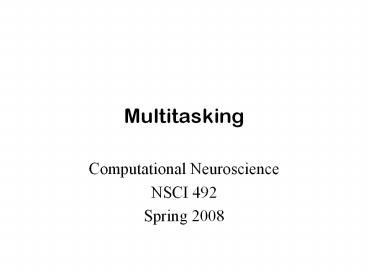Multitasking - PowerPoint PPT Presentation
Title:
Multitasking
Description:
Processing Resources Assumption: ... and motor resources allow for ... buffers provided by the various other resources, the system has a goal buffer. ... – PowerPoint PPT presentation
Number of Views:1869
Avg rating:3.0/5.0
Title: Multitasking
1
Multitasking
- Computational Neuroscience
- NSCI 492
- Spring 2008
2
Course organization
- Syllabus at http//www.tulane.edu/howard/CompNSCI
/
3
Threaded cognition an integrated theory of
concurrent multitasking
- D.D. Salvucci and N.A. Taatgen, 2008,
Psychological Review, 115, 101-130.
4
Thread
- We define a thread as all processing in service
of a particular goal, including procedural
processing through the firing of rules and other
resource processing initiated by these rule
firings.
5
Single-task assumptions
- Processing Resources Assumption
- Human processing resources include cognitive,
perceptual, and motor resources. - Cognitive Resources Assumption
- Cognitive resources include separate procedural
and declarative resources, each of which can
independently become a source of processing
interference. - Declarative Resource Assumption
- Cognitions declarative resource represents
static knowledge as information chunks that can
be recalled (or forgotten). - Procedural Resource Assumption
- Cognitions procedural resource represents
procedural skill as goal-directed production
rules.
6
Single-task assumptions, cont.
- Procedural Learning Assumption
- When learning new tasks, declarative task
instructions are gradually transformed into
procedural rules that perform the task. - Perceptual and Motor Resource Assumption
- The perceptual and motor resources allow for
information acquisition from the environment and
action in the environment.
7
The procedural resource
- The procedural resource, the central resource in
our view of threaded cognition, integrates and
maps currently available results of resource
processing into new requests for further resource
processing. - For example, in the context of a simple choice
task, the procedural resource may map an encoded
visual stimulus and a recalled associated
response into the request to perform a motor
command.
8
Rules
- A (production) rule defines a set of conditions
and actions, such that the conditions must be met
for the rule to execute (or fire) the given
actions. - In the ACT-R formulation of a production rule,
both the conditions and actions utilize buffers
for information transfer - The conditions collate and test information
placed in the buffers by their respective
modules, and if the rule fires, the actions place
new requests for resource processing in the
buffers.
9
Goal buffer
- In addition to the buffers provided by the
various other resources, the system has a goal
buffer. - It can be considered as the procedural resources
own buffer, which stores information about the
current goal of the system. - Typically, production rules include a condition
for the goal buffer that matches only for goals
of a particular typefor instance, a rule that
concerns a choice task matches and fires only
when the current goal indicates that the system
is attempting to perform a choice task.
10
Multitask assumptions
- Threaded Processing Assumption
- Cognition maintains a set of active goals that
produce threads of goal-related processing across
available resources. - Resource Seriality Assumption
- All resources execute processing requests
serially, one request at a time.
11
Resource Usage Assumption
- A thread acquires and releases a resource in a
greedy, polite manner. - A thread acquires a resource in a greedy manner
by requesting it as soon as possible when needed.
- A thread releases a resource in a polite manner
by freeing it for other threads as soon as its
processing is no longer required. - In ACT-R, a resource is in use when
- it is currently performing a processing request
in service of some thread or - the results of a processing request (if any)
remain in the resources buffer still unused by
the requesting thread.
12
Conflict Resolution Assumption
- When threads contend for a procedural resource,
the least recently processed thread is allowed to
proceed. - The primary motivation for this policy is that it
provides a parsimonious way to balance processing
among threads - By ensuring that threads have a regular
opportunity to progress through the firing of
procedural rules, the system allows all threads a
chance to acquire resources and avoids starving
any thread of processing time.
13
Parallelism
- When two threads exhibit similar resource usage,
the least recently processed policy results in an
alternation of rule firings - the procedural resource can fire a rule for one
thread while another threads peripheral
processes (vision, motor, etc.) are running, then
vice-versa, and so on, achieving highly efficient
parallelism between the two. - When two threads exhibit very different resource
usage, the least recently processed policy allows
for the high-frequency task to execute at high
efficiency but still allows the low-frequency
task to acquire the procedural resource when
attention is needed.
14
Summary, p. 112
- Cognition can maintain and execute multiple
active goals, resulting in concurrent threads of
resource processing. - Threads can be characterized as alternating
blocks of procedural processing (i.e., rule
firings that collect information and initiate new
resource requests) and processing on peripheral
resources (including perceptual, motor, and
declarative memory resources). - Processing interference can arise on the central
procedural resource as well as on the
declarative, perceptual, and motor resources. - Threads acquire resources greedily and release
resources politely, which arises naturally from
the characterization of resources as modules and
buffers. - Cognition balances thread execution by favoring
least recently processed threads on the
procedural resource. - With practice, threads become less dependent on
retrieval of declarative instructions, reducing
conflicts for both the declarative and procedural
resources. - Cognition requires no central or supervisory
executive.
15
Next time
- Look at code
- http//act-r.psy.cmu.edu/
- https//www.cs.drexel.edu/salvucci/threads/









![READ[PDF] Veterinary Pathologist Only Because Multitasking N PowerPoint PPT Presentation](https://s3.amazonaws.com/images.powershow.com/10083696.th0.jpg?_=20240723076)





















